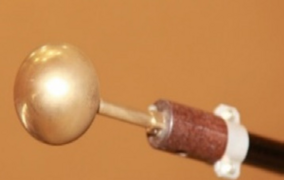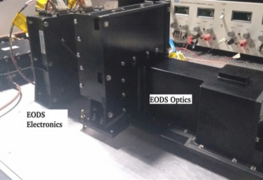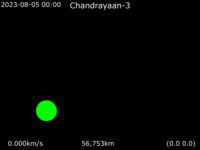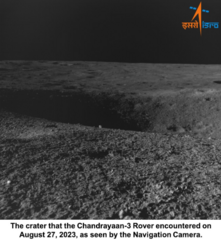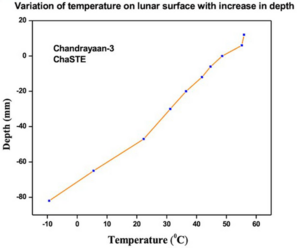Chandrayaan-3 facts for kids
| Mission type |
|
|---|---|
| Operator | ISRO |
| Mission duration | 1 year, 9 months and 12 days (elapsed)
|
| Spacecraft properties | |
| Bus | Chandrayaan |
| Manufacturer | ISRO |
| Launch mass | 3900 kg |
| Payload mass | Propulsion Module: 2148 kg Lander Module (Vikram): 1726 kg Rover (Pragyan) 26 kg Total: 3900 kg |
| Power | Propulsion Module: 758 W Lander Module: 738 W (WS with Bias) Rover: 50 W |
| Start of mission | |
| Launch date | 14 July 2023 09:05:17 UTC |
| Rocket | LVM3 M4 |
| Launch site | Satish Dhawan Space Centre |
| Contractor | ISRO |
| Moon orbiter | |
| Orbital insertion | 5 August 2023 |
| Orbit parameters | |
| Pericynthion | 153 km (95 mi) |
| Apocynthion | 163 km (101 mi) |
| Moon lander | |
| Spacecraft component | Vikram lander |
| Landing date | 23 August 2023 12:32 UTC |
| Landing site | Shiv Shakti point
69°22′23″S 32°19′08″E / 69.373°S 32.319°E (between Manzinus C and Simpelius N craters) |
| Moon rover | |
| Landing date | 23 August 2023 |
| Distance covered | 8 m (26 ft) |
 Mission Insignia |
|
Chandrayaan-3 (transl. Moon-craft, ) is the third Indian lunar exploration mission under the Indian Space Research Organisation's (ISRO) Chandrayaan programme. It consists of a lander named Vikram and a rover named Pragyan, similar to those of the Chandrayaan-2 mission. The propulsion module carried the lander and rover configuration to lunar orbit in preparation for a powered descent by the lander.
Chandrayaan-3 was launched on 14 July 2023. The lander and rover landed near the lunar south pole region on 23 August 2023 at 18:02 IST, making India the first country to successfully land a spacecraft near the lunar south pole and the fourth country to soft-land on the Moon.
Contents
Background
On 22 July 2019, ISRO launched Chandrayaan-2 on board a Launch Vehicle Mark-3 (LVM3) launch vehicle consisting of an orbiter, a lander and a rover. The lander was scheduled to touch down on the lunar surface in September 2019 to deploy the Pragyan rover. The lander ultimately crashed when it deviated from its intended trajectory while attempting to land.
Following Chandrayaan-2, Chandrayaan-3 and further lunar missions were proposed.
The European Space Tracking network (ESTRACK), operated by the European Space Agency (ESA), is supporting the mission. Under a new cross-support arrangement, ESA tracking support could be provided for upcoming ISRO missions such as those of India's first human spaceflight programme, Gaganyaan, and the Aditya-L1 solar research mission. In return, future ESA missions will receive similar support from ISRO's own tracking stations.
Objectives
ISRO set the following mission objectives for the Chandrayaan-3 mission:
- Getting a lander to land safely and softly on the surface of the Moon.
- Observing and demonstrating the rover's driving capabilities on the Moon.
- Conducting and observing experiments on the materials available on the lunar surface to better understand the composition of the Moon.
Spacecraft
Design
Chandrayaan-3 comprised three main components:
- Propulsion module
- The propulsion module carries the lander and rover configuration to a 100 kilometres (62 mi) lunar orbit. It is a box-like structure with a large solar panel mounted on one side and a cylindrical mounting structure for the lander (the Intermodular Adapter Cone) on top.
- Lander
- The Vikram lander is responsible for the soft landing on the Moon. It is also box-shaped, with four landing legs and four landing thrusters capable of producing 800 newtons of thrust each. It carries the rover and various scientific instruments to perform on-site analysis.
- The lander for Chandrayaan-3 has four variable-thrust engines with slew rate changing capabilities, unlike Chandrayaan-2's lander, which had five, with the fifth one being centrally mounted and capable only of fixed thrust. One of the main reasons for Chandrayaan-2 failure, attitude increase during the camera coasting phase, was removed by allowing the lander to control attitude and thrust during all phases of descent. Attitude correction rate is increased from Chandrayaan-2's 10°/s to 25°/s with Chandrayaan-3. Additionally, the Chandrayaan-3 lander will be equipped with a Laser Doppler Velocimeter (LDV) to allow measuring attitude in 3 directions. The impact legs have been made stronger compared to Chandrayaan-2 and instrumentation redundancy has been improved. It will target a more precise 4 km (2.5 mi) by 4 km (2.5 mi) landing region based on images previously provided by OHRC on Chandrayaan-2. ISRO improved the structural rigidity, increased polling in instruments, increased data frequency and transmission, and added additional multiple contingency systems to improve lander survivability in the event of failures during descent and landing.
- Rover
- The Pragyan rover is a six-wheeled vehicle with a mass of 26 kilograms (57 pounds). It is 917 millimetres (3.009 ft) x 750 millimetres (2.46 ft) x 397 millimetres (1.302 ft) in size.
- The rover is expected to take multiple measurements to support research into the composition of the lunar surface, the presence of water ice in the lunar soil, the history of lunar impacts, and the evolution of the Moon's atmosphere.
Payloads
Lander
- Chandra's Surface Thermophysical Experiment (ChaSTE) will measure the thermal conductivity and temperature of the lunar surface.
- Instrument for Lunar Seismic Activity (ILSA) will measure the seismicity around the landing site.
- Langmuir Probe (LP) will estimate near-surface plasma density over time.
Rover
- Alpha Particle X-Ray Spectrometer (APXS) will derive the chemical composition and infer mineralogical composition of the lunar surface.
- Laser-Induced Breakdown Spectroscope (LIBS) will determine the elemental composition (Mg, Al, Si, K, Ca, Ti, Fe) of lunar soil and rocks around the lunar landing site.
Propulsion module
- Spectro-polarimetry of Habitable Planet Earth (SHAPE) will study spectral and polarimetric measurements of Earth from the lunar orbit in the near-infrared (NIR) wavelength range (1–1.7 μm).
Mission profile
Launch
Chandrayaan-3 was launched aboard an LVM3-M4 rocket on 14 July 2023, at 2:35 pm IST from Satish Dhawan Space Centre Second Launch Pad in Sriharikota, Andhra Pradesh, India, entering an Earth parking orbit with a perigee of 170 km (106 mi) and an apogee of 36,500 km (22,680 mi).
Orbit
After a series of manoeuvres that placed Chandrayaan-3 in a trans-lunar injection orbit, ISRO performed a lunar-orbit insertion (LOI) on 5 August, successfully placing the Chandrayaan-3 spacecraft into orbit around the Moon. The LOI operation was carried out from the ISRO Telemetry, Tracking, and Command Network (ISTRAC) located in Bengaluru.
On 17 August, the Vikram lander separated from the propulsion module to begin the last phase of the mission.
Descent
On 23 August 2023, as the lander approached the low point of its orbit, its four engines fired as a braking manoeuvre at 30 kilometres (19 mi) above the Moon's surface. After 11.5 minutes, the lander was 7.2 km (4.5 miles) above the surface; it maintained this altitude for about 10 seconds, then stabilized itself using eight smaller thrusters and rotated from a horizontal to a vertical position while continuing its descent.
It then used two of its four engines to slow its descent to roughly 150 metres (490 ft); it hovered there for about 30 seconds and located an optimal landing spot before continuing downward and touching down at 12:32 UTC.
| Stage and sequence | Date/ Time (UTC) |
LAM burn time | Orbit | Orbital period | References |
|---|---|---|---|---|---|
| Earth orbit: Launch | 14 July 2023 | N/A | 170 km × 36,500 km (110 mi × 22,680 mi) | N/A | |
| Earth bound maneuvers: 1 | 15 July 2023 | N/A | 173 km × 41,762 km (107 mi × 25,950 mi) | N/A | |
| Earth bound maneuvers: 2 | 17 July 2023 | N/A | 226 km × 41,603 km (140 mi × 25,851 mi) | N/A | |
| Earth bound maneuvers: 3 | 18 July 2023 | N/A | 228 km × 51,400 km (142 mi × 31,938 mi) | N/A | |
| Earth bound maneuvers: 4 | 20 July 2023 | N/A | 233 km × 71,351 km (145 mi × 44,335 mi) | N/A | |
| Earth bound maneuvers: 5 | 25 July 2023 | N/A | 236 km × 127,603 km (147 mi × 79,289 mi) | N/A | |
| Trans-lunar injection | 31 July 2023 | N/A | 288 km × 369,328 km (179 mi × 229,490 mi) | N/A | |
| Lunar bound maneuver:1 (Lunar orbit insertion) | 5 August 2023 | 1,835 s (30.58 min) | 164 km × 18,074 km (102 mi × 11,231 mi) | Approx. 21 h (1,300 min) | |
| Lunar bound maneuvers: 2 | 6 August 2023 | N/A | 170 km × 4,313 km (106 mi × 2,680 mi) | N/A | |
| Lunar bound maneuvers:3 | 9 August 2023 | N/A | 174 km × 1,437 km (108 mi × 893 mi) | N/A | |
| Lunar bound maneuvers:4 | 14 August 2023 | N/A | 150 km × 177 km (93 mi × 110 mi) | N/A | |
| Lunar bound maneuvers:5 | 16 August 2023 | N/A | 153 km × 163 km (95 mi × 101 mi) | N/A | |
| Lander deorbit maneuvers: 1 | 18 August 2023 | N/A | 113 km × 157 km (70 mi × 98 mi) | N/A | |
| Lander deorbit maneuvers: 2 | 19 August 2023 | 60 s (1.0 min) | 25 km × 134 km (16 mi × 83 mi) | N/A | |
| Landing | 23 August 2023 12:32 |
TBC | N/A | N/A | |
| Rover deployment | 23 August 2023 | N/A | N/A | N/A |
Mission life
- Propulsion Module: Carries lander and rover to 100 by 100 kilometres (62 mi × 62 mi) orbit, with operation of experimental payload for up to 6 months.
- Lander Module: 1 Lunar Day (14 Earth Days)
- Rover Module: 1 Lunar Day (14 Earth Days)
Team
- ISRO Chairperson: S. Somanath
- Mission Director: S. Mohanakumar
- Associate Mission Director: G. Narayanan
- Project Director: P. Veeramuthuvel
- Deputy Project Director: Kalpana. K
- Vehicle Director: Biju C. Thomas
Funding
In December 2019, ISRO requested the initial funding of the project, amounting to ₹75 crore (US$13 million), out of which ₹60 crore (US$10 million) would be for meeting expenditure towards machinery, equipment, and other capital expenditure, while the remaining ₹15 crore (US$2.6 million) was sought for operating expenditure.
Confirming the existence of the project, ISRO's former chairman K. Sivan stated that the estimated cost would be around ₹615 crore (equivalent to ₹724 crore or US$120 million in 2023).
Results
Since reaching the moon's south pole, Chandrayaan-3 deployed the Pragyan rover to explore the cratered surface, harnessed integrated cameras to send back videos of its environment, and even started working on the research objectives planned for a two-week stay on the moon.
The first video of the rover, posted on 25th August 2023, showed it leaving the Vikram lander on a ramp and driving onto the Moon. ISRO posted the video in a thread on X that also included footage from the lander approaching its landing site and kicking up dust as it touched down on the surface. ISRO wrote afterwards that the rover’s two scientific instruments had been turned on and that it had moved eight meters.
On 26th August, ISRO posted a new video, shot from the lander, of the rover’s drive away, moving almost out of the lander’s sight. On 27th August, it published two pictures after the rover encountered a large crater positioned 3 metres ahead of it's location. However, the rover safely headed on a new path afterwards.
Temperature Variation
ISRO also released a first-of-its-kind data from the observations made by ChaSTE (Chandra’s Surface Thermophysical Experiment), one of the four instruments present on the lander module. ChaSTE was meant to study the heat conductivity of the Moon’s surface and measure the differences in temperatures at different points on and below the surface, with the overall objective of creating a thermal profile of the Moon.
The first set of data released by ISRO showed a very sharp difference in temperatures just above and below the surface of the Moon. A graphical plot put out by ISRO showed that while temperatures on the surface were over 50 degree Celsius, they dropped to nearly -10 degree Celsius just a few millimetres below the surface. The measurements suggested that the topsoil of the lunar surface did not conduct heat very well, and insulated the sub-surface from heat.
These measurements were consistent with what is known about the thermal profile of the Moon from previous expeditions and experiments. But this was the first 'direct measurement' of temperatures of the topsoil and the subsoil near the South Pole of the Moon.
ISRO scientist BH Darukesha , while commenting on the findings, said the high range of 70-degree Celsius temperature near the surface was 'not expected'.
Detection of Sulphur
On 29th August, ISRO said that the Laser-Induced Breakdown Spectroscope (LIBS) instrument onboard the Pragyan rover has 'unambiguously' confirmed the presence of Sulphur in the lunar surface near south pole, through 'first-ever in-situ measurements'. Notably, it had picked up signals that confirm the presence of Sulphur, whose direct evidence was not available yet.
Apart from Sulphur, the rover also detected other elements including Aluminium (Al), Calcium (Ca), Iron (Fe), Chromium (Cr), Titanium (Ti), Manganese (Mn), Silicon (Si), and Oxygen (O). Additionally, the agency said the search for Hydrogen (H) is also underway.
Lunar water
John Bridges, a professor of Planetary Science at the University of Leicester, UK, told New Scientist that due to the low pressure on the moon it would be 'unlikely' for Chandrayaan-3 to find liquid water near to the surface – even in areas where the temperature was above freezing point so water would not be trapped in ice – because it would boil away, although at lower depths the pressure could rise enough to allow liquid water. However, he also added that it’s 'too early', to interpret the readings from Chandrayaan-3. “But it’s fantastic they’re getting data,” Bridges said. “You can’t help comparing it to certain other space agencies; engineers are just getting on now and doing it. They’re sort of overtaking Russia.” he concluded.
Domestic reactions
Congratulating the ISRO team behind the successful Chandrayaan-3 Moon Mission at ISRO Telemetry, Tracking and Command Network in Bengaluru, Prime Minister Narendra Modi announced that the touchdown point of the Vikram lander would henceforth be known as Shiv Shakti point. He further declared August 23, the day the Vikram lander landed on the moon, as National Space Day.
See also
 In Spanish: Chandrayaan-3 para niños
In Spanish: Chandrayaan-3 para niños
- Moon landing
- LUPEX
- Chandrayaan-2
- Indian Space Research Organisation
- List of missions to the Moon
- Chandrayaan-1
- Indian Human Spaceflight Programme – Indian manned space programme
- Indian Martian Exploration Programme – Indian Mars exploration programme
- Venus Orbiter Mission – Indian Venus exploration mission
- Aditya-L1 – Indian solar observation mission
- Gaganyaan – crewed spacecraft being developed by the Indian Space Research Organisation






